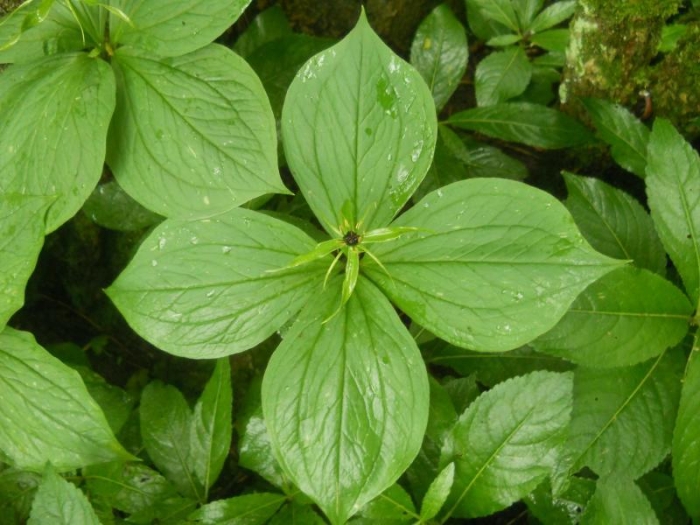Herb Paris
(Paris quadrifolia)
Herb Paris (Paris quadrifolia)
/
/

Andre Hosper
CC BY 4.0
Image By:
Andre Hosper
Recorded By:
Copyright:
CC BY 4.0
Copyright Notice:
Photo by: Andre Hosper | License Type: CC BY 4.0 | License URL: http://creativecommons.org/licenses/by/4.0/ | Rights Holder: Andre Hosper | Publisher: iNaturalist | Date Created: 41425 |
























Estimated Native Range
Summary
Paris quadrifolia, commonly known as Herb Paris or True Lover’s Knot, is a perennial herb native to temperate regions of Eurasia. It is typically found in the understory of deciduous forests, often in association with ancient woodland indicators, indicating long-standing, undisturbed habitats. This plant prefers moist, well-drained, calcareous soils and thrives in dappled shade, such as that found in old woods and along stream banks. Paris quadrifolia grows to a height of 10 to 16 inches and is notable for its whorl of typically four broad leaves and a single, small, star-shaped flower. The flower, which blooms in late spring, has greenish-yellow filiform petals and a prominent, dark purple ovary at its center, making it quite distinctive, though not particularly showy.
The plant is valued for its unique foliage and the architectural quality it brings to shade gardens. It is often used in woodland plantings and for naturalizing in shady areas. In cultivation, it requires consistently moist soil and protection from intense sunlight. While not widely used in modern herbalism due to its toxicity, Herb Paris has a history of medicinal use, primarily in traditional medicine. Gardeners should be aware that all parts of the plant are poisonous if ingested. The plant is also known for producing a single, blueberry-like fruit after flowering, which is also toxic. Due to its rarity and decline in Europe, largely from habitat destruction, it is considered a species of conservation concern in some regions.CC BY-SA 4.0
The plant is valued for its unique foliage and the architectural quality it brings to shade gardens. It is often used in woodland plantings and for naturalizing in shady areas. In cultivation, it requires consistently moist soil and protection from intense sunlight. While not widely used in modern herbalism due to its toxicity, Herb Paris has a history of medicinal use, primarily in traditional medicine. Gardeners should be aware that all parts of the plant are poisonous if ingested. The plant is also known for producing a single, blueberry-like fruit after flowering, which is also toxic. Due to its rarity and decline in Europe, largely from habitat destruction, it is considered a species of conservation concern in some regions.CC BY-SA 4.0
Plant Description
- Plant Type: Herb
- Height: 0.6-0.75 feet
- Width: 1-2 feet
- Growth Rate: Slow
- Flower Color: Green, White
- Flowering Season: Spring, Summer
- Leaf Retention: Deciduous
Growth Requirements
- Sun: Full Shade
- Water: Medium
- Drainage: Medium
Common Uses
Low Maintenance, Potted Plant, Rock Garden
Natural Habitat
Deciduous forest understories in temperate Eurasia, often in ancient woodlands with moist, calcareous soils
Other Names
Common Names: True Lover’s Knot
Scientific Names: , Paris quadrifolia, Paris pentafolia, Paris quadrifolia var. angustiovata, Paris trifolia,
GBIF Accepted Name: